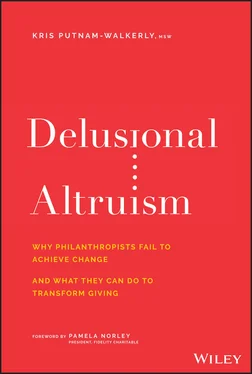Lack of Investment in Nonprofit Talent and Capacity
Well-meaning philanthropists just like you have a scarcity mind-set when it comes to investing in the talent and organizational capacity of grantees. Simply stated, you don't invest enough. And what you do invest is too often tied up in unfair and unnecessary hoops, hurdles, and hoopla.
As you know, your grantees are helping you achieve your philanthropic mission. Chances are high that you, the philanthropist, aren't the person building low-income housing in Philadelphia, installing portable toilets in Ghana, or training the next generation of teachers of color. Your grantees are.
And, as you know, your grantees are comprised of people. Amazing people. These outstanding people rely upon information, training, technology, curriculum, fundraising, financial systems, governance, and a host of other things to do their best work.
Don't you want the most talented people doing their best work to help you fulfill your mission? Of course you do!
Yet time and again, funders withhold investment in grantee talent and infrastructure. Do you want your grantees to have mediocre financial management systems, outdated technology, and lackluster board governance? Of course you do not! Yet philanthropists just like you overlook these real needs all the time.
Instead, you believe all your money should “help people” (or animals, or the environment), without recognizing the needs of the organizations doing the help. You have a scarcity mind-set, and it's undermining your effectiveness. Let me share a few examples.
One donor told me she would not allow grant dollars to pay for personnel costs of their grantees! You read that right. She will fund a program, but not the employees who run the program. She might fund a tutoring program, but funds could not be used to pay the tutors. Or she would support policy advocacy, but her grant could not be spent on the advocates.
How on earth can you expect students to learn without people to teach them, or legislators to vote differently if the policy advocate cannot meet with them? You can't. To think otherwise is delusional.
Not paying for personnel costs is one example of a scarcity mind-set. Another is paying below-market rates. In reflecting on the UK-based Shell Foundation's 15 years of investment in social entrepreneurs, former Portfolio Director Simon Desjardins explained how underinvestment in talent resulted in poor outcomes:
Though most recognize the importance of building a world-class team, few are prepared to pay for it. In many quarters, it is still assumed that because an enterprise has a social objective, its compensation levels can and should be below market…. In some regions (especially Africa, where there is often a shortage of trained professionals), investors and even some entrepreneurs will balk at the idea of paying … a market-related salary and typically opt for someone with a lesser track record. Time and again, we have seen this decision backfire and result in lost time and wasted money. 3
Increasingly, philanthropists are recognizing that to achieve real outcomes, they must pay the real costs necessary to achieve those outcomes. Philanthropy California, an alliance of three regional associations of grantmakers, and the Nonprofit Finance Fund have come together to create the Full Cost Project. The goal of this initiative is to increase philanthropy's impact by adopting new funding strategies centered on the needs of today's social sector organizations. According to a report issued by this association of grantmakers:
Real cost funding is not about overhead rates. Rather, it is a holistic approach to grantmaking that starts with the end in mind—what are the outcomes we are looking to achieve and what does it really cost to deliver those outcomes? … Simply put, the real cost of outcomes includes all of the necessary costs for a nonprofit organization to deliver on mission and to be sustainable over the long term. 4
These might include the costs of donation management systems, strategy development, talent recruitment, professional development, fund development, financial management, board development, information technology upgrades, data collection and evaluation, start-up costs, and more.
In an open letter to all U.S. donors, Charity Navigator, GuideStar, and BBB Wise Giving Alliance encouraged all donors to move beyond the myth that low overhead rates mean better nonprofit performance:
In fact, many charities should spend more on overhead. Overhead costs include important investments charities make to improve their work: investments in training, planning, evaluation, and internal systems—as well as their efforts to raise money so they can operate their programs. These expenses allow a charity to sustain itself (the way a family has to pay the electric bill) or to improve itself (the way a family might invest in college tuition). 5
Yet most nonprofits continue to feel hamstrung by the philanthropic donations that are supposed to help them. In its 2018 survey of 3,400 U.S. nonprofit leaders, the Nonprofit Finance Fund identified nonprofits' top challenges. These included achieving financial sustainability (62%), raising funding to cover full costs (57%), and offering competitive pay (66%). 6
This scarcity mind-set isn't limited to philanthropists in the United States. Italy's history and culture have contributed to societal beliefs that social sector organizations do not warrant infrastructure investment, according to Carola Carazzone, secretary general of Assifero, an Italian association of grantmaking foundations and institutional philanthropy. This includes a culture of Catholic voluntary service and a social services system in which for hundreds of years services have been provided free of charge by the church and, for the most part, by women.
“The spiral of producing [and] reporting projects only to match the priorities of calls for proposals launched by public and private funders, together with the perpetuation of a chronic underinvesting in the organizations, skills, and staff has led Italian civil society to the failure to develop its full potential,” argues Carazzone. This has resulted in a culture of “low pay, make do, and do without.” 7
Charitable organizations in Kyrgyzstan, a Central Asian country bordering China and Uzbekistan, face even stricter challenges. They are “… obliged by law to spend 98% of their income on a charitable purpose or purposes within a year after receiving a donation, and thus leaving only 2% of this income to cover general overhead costs, including the salaries of personnel,” according to Dinara Musabekova, director of the Civil Society Initiative at the University of Central Asia. 8
How Do You Know If You Have a Scarcity Mind-Set?
Do you suffer from a scarcity mind-set? Don't take this personally, but chances are high that you do. I do, too. We all experience this at some point. I commonly see eight warning signs among philanthropists.
Take this eight-question Scarcity Mind-Set Quiz and see if a scarcity mentality might be holding you back. Give yourself a point for each question you answer affirmatively:
1 You frequently ask, “What's the cheapest way we can do this?” regardless of impact on quality, speed, or your discomfort. For example, you'll take a red-eye flight home to save money on hotel costs, even though it means you are exhausted and unproductive the next day.
2 You don't regularly make investments in your talent and infrastructure, or that of your grantees. This might include getting professional development or coaching, upgrading computer systems, attending conferences, evaluating your impact, etc.
3 Your workplace culture values working harder, not smarter. For example, people are expected to work late hours or on weekends, long meetings are the norm, and there are always lengthy processes for strategic planning or budgeting.
Читать дальше












